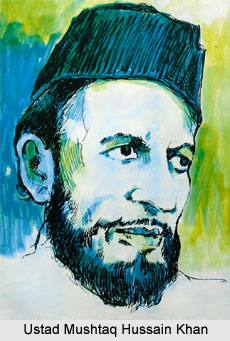 Established by Inayat Hussain Khan (1849-1916), the son-in-law of Haddu Khan of Gwalior fame, this gharana is regarded as an offshoot of the Gwalior gayaki. In later years, singers also imbibed aspects of the Agra gharana into their gamut. Inayat`s brothers were beenkars in the court of the Nawab of Rampur. Inayat, though trained in the Gwalior idiom, also picked up dhrupad and settled down in the Rampur court. He belonged to the village of Sahaswan and thus the style earned the joint names of the place of his origin and that of his patron`s domain. Besides being an exceedingly accomplished musician, he was also a gifted composer. Many of his haunting bandishes are popular among singers from other styles even today, especially Jhanana jhanana jhan in Chayanat.
Established by Inayat Hussain Khan (1849-1916), the son-in-law of Haddu Khan of Gwalior fame, this gharana is regarded as an offshoot of the Gwalior gayaki. In later years, singers also imbibed aspects of the Agra gharana into their gamut. Inayat`s brothers were beenkars in the court of the Nawab of Rampur. Inayat, though trained in the Gwalior idiom, also picked up dhrupad and settled down in the Rampur court. He belonged to the village of Sahaswan and thus the style earned the joint names of the place of his origin and that of his patron`s domain. Besides being an exceedingly accomplished musician, he was also a gifted composer. Many of his haunting bandishes are popular among singers from other styles even today, especially Jhanana jhanana jhan in Chayanat.
In the 20th century it was the celebrated Ustad Mushtaq Hussain Khan (1874-1962) who carried the tradition forward. Trained by two doyens of the Rampur style, initially by Haider Khan and, later, by Inayat Khan himself at Kathmandu, where the latter was a court musician, Mushtaq also picked up dhrupad dhammar from the celebrated Wazir Khan of Rampur court. Like Ustad Faiyaz Khan of Agra, his music which germinated in the old khandani (dynastic) ethos and was fostered in the old darbars, carried the weightage and solidity of gharanedaar gayaki (immaculate and orthodox style). To hear his old records is to summon the nostalgic ambience of leisurely feudal times. His sweep and range were wide. His command over all the technical aspects of khayal gayaki made him the envy of every contemporary musician, as did the wide range and the sheer force of his voice.
Nissar Hussain Khan (1912-1993) was another reputed singer this gharana, produced in the 20th century. An acknowledged master of the tarana, his technical virtuosity has been applauded by countless. Some of the renowned singers of this gharana are Ishtiaq Hussain Khan, Ghulam Mustafa Khan, Sulochana Brihaspati, Sarfraz Hussain Khan, hafeez Ahmed, Ghulam Sadiq Khan, Shanno Khurana and the versatile Rashid Khan.
Some of the noteworthy characteristics of the Rampur style are
• Extensive use of bol-alaap (raaga elaboration using select phrases from the song-text) to evoke the appropriate rasa associated with raaga.
• Methodical rendition of the sthayi and the antara keeping with the Gwalior heritage.
• Use of aakaar singing.
• Proficiency in singing different varieties of taans worth great clarity, power and speed.
• Mastery over tarana. In fact, the singers of this gharana are considered the masters of this form.




















